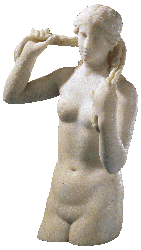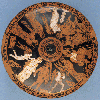|
The ancient Greeks were a deeply religious people. They worshipped many gods whom they believed appeared in human form and yet had superhuman strength and ageless beauty. The Iliad and the Odyssey, our earliest surviving examples of Greek literature, record men's adventures with various gods and goddesses. They were written by Homer, a poet living at the end of the 8th century BC. Each Greek city was normally under the protection of one or more individual gods. For example, Athens especially worshipped the goddess Athena. While many sanctuaries were for more than a single god, usually they were for one deity such as Zeus at Olympia or a closely linked pair of deities like Demeter and her daughter Persephone at Eleusis. Painted scenes on vases, and stone, terracotta and bronze sculptures show the major gods and goddesses. |

Marble Statuette of Aphrodite, Above |
|
Attic Red Figure Pyxis |
|
Marble Head of Athena |

